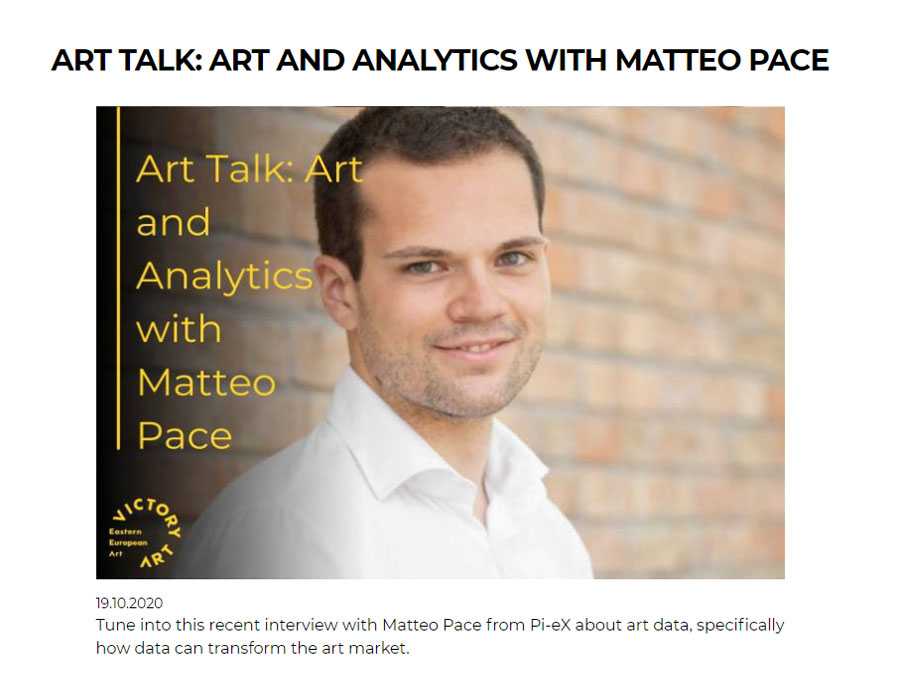MUST READ ART BLOGS
Art Talk: Art and Analytics with Matteo Pace

Tune into this recent interview with Matteo Pace from Pi-eX about art data, specifically how data can transform the art market.
INTRODUCING MATTEO PACE FROM PI-EX ABOUT ART MARKET
My name is Mateo and I currently work for Pi-eX, which is a London-based company, authorized financial broker-dealer that delivers innovative financial tools and solutions for all art market stakeholders. I'm in charge of the research team, leveraging all of the research we do with the rest of the team. Before joining Pi-eX a year and a half ago, I graduated in economics and worked for a private bank in Milan for some months, eventually moving to London where I took a master's at Christie's. After I worked for Christie's for the first month before joining Pi-eX.
1. HOW IS ART CONNECTED WITH ANALYTICS IN THE ART MARKET?
MP: The sky's the limit when you have the word, but jokings apart. When we think about art, we can indefinitely and immediately associate it with the value of the art itself, which uses the aesthetic, it's historical, it's contextual, it's the value from its artistic perspective. However, there is also another kind of value that can be extrapolated from art, which is the trade value, which is sampling absolutely complimentary. Trade value is when something unique, like an artwork, is sold for whatever reason, therefore it generates the trade.
So there is a market for this trade. We can talk about data in the art market when we can see an exchange. Evidence of trade is when exchanges happened between the various stakeholders, mainly two. One is the private site, the other is the public site. As the name suggests, the private side is extremely difficult to track because we're on the private side, which is extremely difficult to assess and it may not generate meaningful results when running an analysis because it's so hidden. The public one, everyone can access for example the auction room. They can record auctions, watch what happens in an auction. This allows consistency in the reporting and completeness. It is important because when there is a sale between a seller and the buyer, there are two sides. One is the supply and one is the demand. When we look at the trade data of art, it is possible to run meaningful analysis and look at the various sides of the market.
2. CAN THERE BE AN EMOTIONAL PURCHASE OF ART BASED ON RATIONAL DATA?
MP: This is a very tricky question but the answer is, absolutely! A word that I already used before is complementarity. Rational data can be complementary to an emotional purchase. They can be complementary because when we have rational data, our experience in buying art can be enhanced and safer. Rational data can really drive our emotions in the financial market. The concept is that data doesn't kill emotion. It helps to avoid mistakes. Data helps us in this amazing journey of art. Rational data can really help all art markets, they called us in creating the right context for everybody, for all of the art ecosystems. Another important idea I'd like to mention is the role of expectations and especially the alignment of expectations. When there is a sale at the auctions and an artwork is effectively sold, it means that the buyers and the seller agreed on the same. A certain price that the seller expected was met by the buyer who was willing to put the amount of money for the artwork that the seller was offering.
Data can help both the seller and the buyer with their expectations. For example, setting the right budget in very practical terms. Not to overpay, so a reasonable reserve price. The reserve price at auction is the minimum price at which artwork will be sold, otherwise will be unsold or pass. Those are technical terms to say. One of the biggest issues in their market is liquidity. Liquidity means the artwork can be easily sold and so generate and transform your artwork into effective money. Data doesn't kill emotionality. It brings certainty, for example, about the past and leveraging on meaningful analysis. It creates a win-win situation for all of its markets and stakeholders.
3. IS THE ART DATA OUT THERE REAL? HOW DO WE KNOW IF IT'S REAL?
MP: Everywhere writes that the art market is booming here and there. So the first good news I believe is that there is data on your market, which is available because sometimes when we think about the art market, the first image in your head is "Oh my gosh, it's a shady market". "It's a handshake business". Everything is done in the private members club rooms and it's very hidden. However, actually, there is data on the market. Some considerations and trends can be extrapolated in the public world. The auction site is the most transparent area of the market.
Once we establish that there is available data, it comes to the second layer that answers your question if the market data are real. They are, and they are numbers. They are not intangible things. But as an analyst, we need to have the responsibility of questioning ourselves about the quality of data. In this specific kind of market, quantity doesn't go along with quality. I would rather talk about smart data. The quality of your input depends on the quality of your output, which means if you are not 100% or 1000% sure of the material you have, you cannot expect to have an amazing outcome of your analysis.
What do I mean by the amazing outcome? It is an analysis that reflects what's actually going on in the market. Reports which are really meaningful and representative of the market. The art market is extremely fascinating, but also because it's problematic in terms of difficulties in communication as you mentioned right now that it is written that the market is booming. Actually, the market is struggling. The market is correlated to the financial war because people who invest in the financial world are also the ones who realistically have the capabilities of investing in the art market. So the narrative which is written in articles is sometimes not representative of the effective health state of the market.
Why it is important to have a very solid and strong methodology for talking about data in your market. For example, what's happening right now with COVID. If it wasn't for the availability of data, governments would not be able to assess their policies. So they rely on data to drive their actions in a similar fashion. If we want sustainable and growing art marketing in the long term, we need to create this culture of sharing, not being secretive about your data. Let's be open. As they do in the scientific community, be open with other researchers. Share, share, and talk which are the features of meaningful data.
The very final point is the narrative that is spoken and told to prospective buyers, maybe future buyers are having a wrong perception of what's going on is absolutely detrimental, because as newcomers into this amazing market, as young professionals, when you have some capital, we hear that, the art market is always great. They then make an investment only to find out later that the information was not assessed correctly so these new collectors aren't able to sell their artwork, therefore they are disappointed and will not associate with the art market anymore. So the market will shrink, shrink, and shrink. However, this is a pessimistic scenario. Nevertheless, a culture of openness of transparency and effective awareness of the situation of the market is a win-win, for everybody
4. HOW CAN AN UPCOMING ART BUYER LEVERAGE DATA FROM PI-EX?
MP: By speaking the same language. At Pi-eX, we really want to have a very ambitious mission to speak a new language in the art market. We don't say our data on the art market is the best one. You have to take them as a commandment. We just want to create this new culture of let's talk about it. Let's discuss this. Like every language at first, it takes time to understand but once you understand you get in tune with a lot of exercise and patience, the results will be amazing. We provide reports which are simple visual graphics at extremely accessible prices. You can also leverage our data by reading our blog, our articles, videos like this interview, or the recent series of Pi-eX. The series launched months ago where I interviewed two extremely senior professionals to comment on the current state of the art market.
We have reports that look at macro mezzo and micro levels. Even at an artist level, we create our own index, which can be used as a starting point for running other analyses. Also since we regulate the company as the basis for innovative financial solutions, effectively investments.
You can find out more information about Mateo Pace here:
CHECK OUT OUR BEST BLOGS

.webp)

.webp)
.webp)
.webp)
.webp)
.webp)








.jpg)